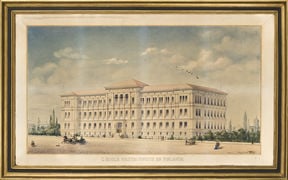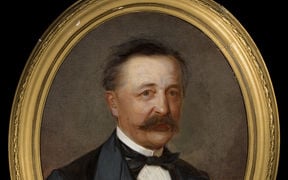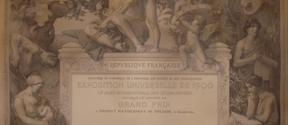A dedicated building at the edge of town
As early as 1 May 1862, an imperial decree ordered an estimate to be made for an entirely new school building. Several sites had been suggested: first the area bordered by Yrjönkatu, Annankatu and Simonkatu; then Aleksanterinkatu 27, where the Student Union of the University of Helsinki would later build what is today known as the Old Student House. Other sites considered included a plot of land on Katajannokka as well as the land where the Bank of Finland is located today. Ultimately, the Helsinki magistrate signed over an area beside the Hietalahti Market in the Kurki block as the site of a new building.
The new building was designed by Frans Anatolius Sjöström, who during 1869–1871 had received the education needed to serve as the school's teacher of architecture following the death of W. L. Bähr. Sjöström had previously studied at the Royal Academy of Fine Arts in Stockholm with great success.
Designing the building was made a part of qualifying for the position of architecture teacher. The Manufactory Board tasked Sjöström with studying the particulars of school buildings during a trip abroad and with drawing up a general plan for the construction. Sjöström submitted his application for the vacancy on 26 June 1869 along with a request for a travel stipend for rounding out his education, noting that he would be willing to accept the position if the government paid for two years of studies abroad.
The Manufactory Board accepted the application as soon as it was received and presented the matter to the Senate's financial department the next day. The Senate, for its part, assented to keeping the position vacant for the time being, with part of the funds intended for the teacher's salary redirected to Sjöström as a stipend. Meanwhile, engineer Endre Lekve took responsibility for teaching the basics of architecture for a partial salary, and advanced courses were cancelled. Sjöström's grant was extended by four months in June 1871.
The public buildings administration presented an itemised budget for the construction of the new Polytechnic School building in December 1872. As the move to the new building was eventually delayed, F.L. Litonius allowed the school to extend its stay in the Litonius building with the lease largely unchanged.
The new main building was completed in 1877, with a total of 4 300 m2 in floor space in its original configuration. In addition to the school itself, the building housed a number of government offices for education, industry and geology.
Rise of the Hietalahti campus
The school quickly ran out of space and the building underwent many renovations to expand it. An extension designed by Carl Gustaf Nyström and completed in 1904 added 3 600 m2 of floor space and expanded the school building to the edges of the lot limited by Bulevardi and Antinkatu (present-day Kalevankatu). The geologists' office was also moved to a new separate building on Bulevardi.
Until the 1920s, the chemical laboratory was the only laboratory in the Polytechnic Institute and later Helsinki University of Technology with proper facilities. The old chemical laboratory was completed in 1877 and the so-called new laboratory in 1898. The new main building did not include technical laboratories before the building reached its present-day form during 1926–1928, when two floors and 2 100 m2 of space were added to the central wing of the building, as designed by Armas Lindgren.
Mechanical engineering laboratories for the school would not be constructed until after the end of the First World War.


